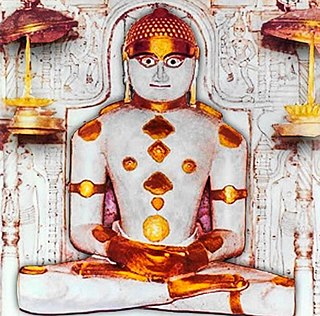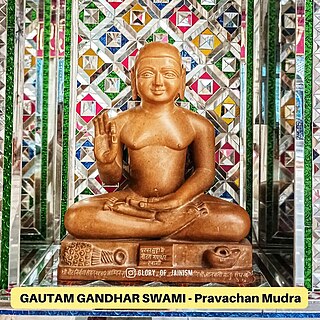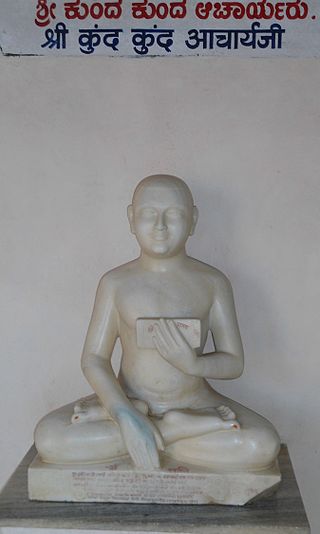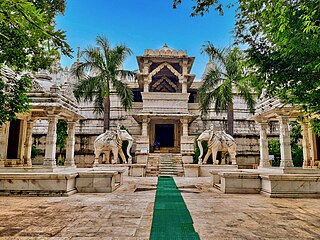
Mahavira, also known as Vardhamana, was the 24th Tirthankara of Jainism. He was the spiritual successor of the 23rd Tirthankara Parshvanatha. Mahavira was born in the early 6th century BCE to a royal Kshatriya Jain family of ancient India. His mother's name was Trishala and his father's name was Siddhartha. According to the second chapter of the Śvētāmbara Ācārāṅga Sūtra, Siddhartha and his family were devotees of Parshvanatha. Mahavira abandoned all worldly possessions at the age of about 30 and left home in pursuit of spiritual awakening, becoming an ascetic. Mahavira practiced intense meditation and severe austerities for twelve and a half years, after which he attained Kevala Jnana (omniscience). He preached for 30 years and attained moksha (liberation) in the 6th century BCE, although the year varies by sect.

In Jainism, a Tirthankara is a saviour and supreme preacher of the dharma. The word tirthankara signifies the founder of a tirtha, a fordable passage across saṃsāra, the sea of interminable birth and death. According to Jains, tirthankaras are the supreme preachers of dharma, who have conquered saṃsāra on their own and made a path for others to follow. After understanding the true nature of the self or soul, the Tīrthaṅkara attains kevala jnana (omniscience). A Tirthankara provides a bridge for others to follow them from saṃsāra to moksha (liberation).

Ādi purāṇa is a 9th-century CE Sanskrit poem composed by Jinasena, a Digambara monk. It deals with the life of Rishabhanatha, the first Tirthankara.

Parshvanatha, or Pārśva and Pārasanātha, was the 23rd of 24 Tirthankaras of Jainism. Parshvanatha is one of the earliest Tirthankara who is acknowledged as a historical figure. The Jain sources place him between the 9th and 8th centuries BCE whereas historians consider that he lived in the 8th century BCE.
In Jainism, godliness is said to be the inherent quality of every soul. This quality, however, is subdued by the soul's association with karmic matter. All souls who have achieved the natural state of Unlimited bliss, Unlimited knowledge, Unlimited power and Unlimited perception are regarded as God in Jainism. Jainism rejects the idea of a creator deity responsible for the manifestation, creation, or maintenance of this universe. Instead, souls who have reached Heaven for their merits and deeds influence the Universe for a fixed period until they undergo reincarnation and continue the cycle of enlightenment. According to Jain doctrine, the universe and its constituents have always existed. All constituents and actions are governed by universal natural laws and "perfect soul".

Rishabhanatha, also Rishabhadeva, Rishabha or Ikshvaku, is the first tirthankara of Jainism. He was the first of twenty-four teachers in the present half-cycle of time in Jain cosmology and called a "ford maker" because his teachings helped one cross the sea of interminable rebirths and deaths. The legends depict him as having lived millions of years ago. He was the spiritual successor of Sampratti Bhagwan, the last Tirthankara of the previous time cycle. He is also known as Ādinātha, as well as Adishvara, Yugadideva, Prathamarajeshwara and Nabheya. He is also known as Ikshvaku, establisher of the Ikshvaku dynasty. Along with Mahavira, Parshvanath, Neminath, and Shantinath, Rishabhanatha is one of the five Tirthankaras that attract the most devotional worship among the Jains.
A manastambha is a pillar that is often constructed in front of Jain temples or large Jain statues. In North India, they are topped by four Tirthankara images.

King Nabhi or Nabhi Rai was the 14th or the last Kulakara of avasarpini. He was the father of Rishabhanatha, the first tirthankara of present avasarpini. According to Jain text Ādi purāṇa, Nabhirāja lived for 1 crore purva and his height was 525 dhanusha.
The Solar dynasty or Sūryavaṃśa, also called the Ikshvaku dynasty, is a legendary Indian dynasty said to have been founded by Ikshvaku. In Hindu literature, it ruled the Kosala Kingdom with their capital at Ayodhya and later at Shravasti. They prayed to their clan deity Surya, after whom the dynasty formed its namesake. Along with the Lunar dynasty, the Solar dynasty comprises one of the main lineages of the Kshatriya varna in Hinduism.

In Jainism, the term Ganadhara is used to refer the chief disciple of a Tirthankara. In samavasarana, the Tīrthankara sat on a throne without touching it. Around, the Tīrthankara sits the Ganadharas. According to Digambara tradition, only a disciple of exceptional brilliance and accomplishment (riddhi) is able to fully assimilate, without doubt, delusion, or misapprehension, the anekanta teachings of a Tirthankara. The presence of such a disciple is mandatory in the samavasarana before Tirthankara delivers his sermons. Ganadhara interpret and mediate to other people the divine sound (divyadhwani) which the Jains claim emanates from Tirthankara's body when he preaches.

Gautama Swami, born as Indrabhuti Gautama was the first Ganadhara of Mahavira, the 24th and last Jain Tirthankara of present half cycle of time. He is also referred to as Guru Gautama, Gautama Ganadhara, and Ganadhara Gautama Swami.
According to the Jain cosmology, the Śalākāpuruṣa "illustrious or worthy persons" are 63 illustrious beings who appear during each half-time cycle. They are also known as the triṣaṣṭiśalākāpuruṣa. The Jain universal or legendary history is a compilation of the deeds of these illustrious persons. Their life stories are said to be most inspiring.

Digambara is one of the two major schools of Jainism, the other being Śvetāmbara (white-clad). The Sanskrit word Digambara means "sky-clad", referring to their traditional monastic practice of neither possessing nor wearing any clothes.
Panch Kalyanaka are the five chief auspicious events that occur in the life of tirthankara in Jainism. They are commemorated as part of many Jain rituals and festivals.

Jain art refers to religious works of art associated with Jainism. Even though Jainism has spread only in some parts of India, it has made a significant contribution to Indian art and architecture.

In Jainism, Bharata was the first chakravartin of the Avasarpini. He was the eldest son of Rishabhanatha, the first tirthankara. The ancient name of India was named "Bhāratavarsha" or "Bhārata" or "Bharata-bhumi" after him. He had two sons from his chief-empress Subhadra, named Arkakirti and Marichi. He is said to have conquered all six parts of the world and to have engaged in a fight with Bahubali, his brother, to conquer the last remaining city of the world.

Samantabhadra was a Digambara ācārya who lived about the later part of the second century CE. He was a proponent of the Jaina doctrine of Anekāntavāda. The Ratnakaranda śrāvakācāra is the most popular work of Samantabhadra. Samantabhadra lived after Umaswami but before Pujyapada.

Marudevī was the mother of the first Jain Tirthankara, Rishabhanatha and the queen of King Nabhi. According to the Śvetāmbara canon, she was the first person to have attained Moksha in the current Avasarpiṇī.
In Jainism, kulakara refers to the wise men who teach people how to perform the laborious activities for survival. According to Jain Cosmology, when the third ara (epoch) of the avasarpani was nearing its end, felicities due to ten type of Kalpavriksha started declining. The number of the sages who thus appeared is said to be fourteen, the last of whom was Nabhirai, the father of the first tirthankara, Rishabhanatha.

The Kumbharia Jain temples is a group of five Jain temples in the Kumbhariya, Banaskantha district in Gujarat, India. Constructed from 1062 to 1231 CE during the reign of the Chaulukya dynasty, they are noted for their elaborate architecture.




















